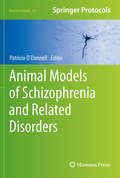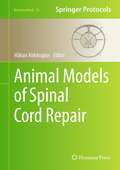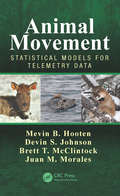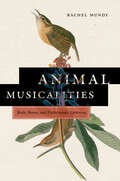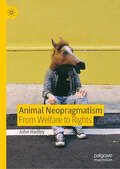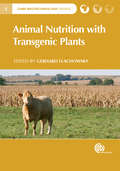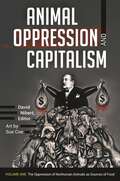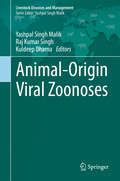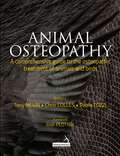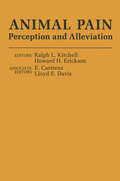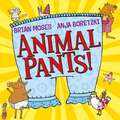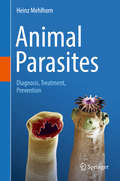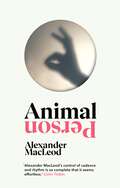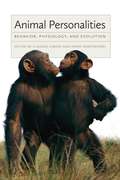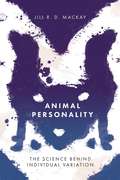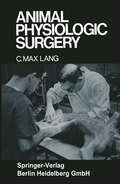- Table View
- List View
Animal Models of Schizophrenia and Related Disorders (Neuromethods #59)
by Patricio O'DonnellAnimal models of schizophrenia and other major psychiatric disorders have been sought for decades, and, as a result, we are now facing new vistas on pathophysiology that could lead to novel therapeutic approaches and even hint at possible preventive strategies. Animal Models of Schizophrenia and Related Disorders presents an overview of the information that can be obtained with several different models and a detailed account of how to generate such models in order to ensure that the manipulations used to model schizophrenia-relevant phenomena are used consistently across laboratories. This detailed volume features pharmacological models such as non-competing NMDA antagonists, emphasizing their use in vitro, neurodevelopmental models such as the neonatal ventral hippocampal lesion and the antimitotic MAM, models that reproduce environmental factors such as neonatal hypoxia, vitamin D deficits, and prenatal immune activation, as well as several different genetic model approaches. As a volume in the Neuromethods series, this volume contains the kind of detailed description and implementation advice that is crucial for getting optimal results.Practical and cutting-edge, Animal Models of Schizophrenia and Related Disorders highlights the successes in the use of animal models to gain insight on pathophysiological mechanisms of relevance to major psychiatric disorders in the hope of inspiring investigators to expand the research and test targets that could restore or ameliorate function.
Animal Models of Spinal Cord Repair (Neuromethods #76)
by Håkan AldskogiusThe development of treatment strategies that can help patients with spinal cord injury to regain lost functions and an improved quality of life is a major medical challenge, and experimental spinal cord research has to meet these challenges by resolving fundamental problems, establishing a basis for possible novel treatment strategies of spinal cord injury, and motivating their clinical translation. In Animal Models of Spinal Cord Repair, expert researchers examine a broad range of experimental models for research on spinal cord injury, how they have contributed to our current state of knowledge, and what their advantages are in the further advancement of spinal cord repair. With models from simple lamprey to non-human primates, the information presented is intended to guide the implementation of animal models for spinal cord repair as well as to raise the awareness of the relevance of experimental models which may not be in the current mainstream of this research. As a part of the Neuromethods series, this work contains the kind of detailed description and implementation advice to guarantee successful results in the laboratory. Comprehensive and cutting-edge, Animal Models of Spinal Cord Repair presents the background information and hands-on methods descriptions, as well as the basic and clinical issues, needed to stimulate and guide researchers with different backgrounds towards the development of improved strategies for functionally relevant repair of the injured human spinal cord.
Animal Movement: Statistical Models for Telemetry Data
by Mevin B. Hooten Devin S. Johnson Brett T. McClintock Juan M. MoralesThe study of animal movement has always been a key element in ecological science, because it is inherently linked to critical processes that scale from individuals to populations and communities to ecosystems. Rapid improvements in biotelemetry data collection and processing technology have given rise to a variety of statistical methods for characterizing animal movement. The book serves as a comprehensive reference for the types of statistical models used to study individual-based animal movement. Animal Movement is an essential reference for wildlife biologists, quantitative ecologists, and statisticians who seek a deeper understanding of modern animal movement models. A wide variety of modeling approaches are reconciled in the book using a consistent notation. Models are organized into groups based on how they treat the underlying spatio-temporal process of movement. Connections among approaches are highlighted to allow the reader to form a broader view of animal movement analysis and its associations with traditional spatial and temporal statistical modeling. After an initial overview examining the role that animal movement plays in ecology, a primer on spatial and temporal statistics provides a solid foundation for the remainder of the book. Each subsequent chapter outlines a fundamental type of statistical model utilized in the contemporary analysis of telemetry data for animal movement inference. Descriptions begin with basic traditional forms and sequentially build up to general classes of models in each category. Important background and technical details for each class of model are provided, including spatial point process models, discrete-time dynamic models, and continuous-time stochastic process models. The book also covers the essential elements for how to accommodate multiple sources of uncertainty, such as location error and latent behavior states. In addition to thorough descriptions of animal movement models, differences and connections are also emphasized to provide a broader perspective of approaches.
Animal Movement: Statistical Models for Telemetry Data
by Juan M. Morales Mevin B. Hooten Devin S. Johnson Brett T. McClintockThe study of animal movement has always been a key element in ecological science, because it is inherently linked to critical processes that scale from individuals to populations and communities to ecosystems. Rapid improvements in biotelemetry data collection and processing technology have given rise to a variety of statistical methods for characterizing animal movement. The book serves as a comprehensive reference for the types of statistical models used to study individual-based animal movement. Animal Movement is an essential reference for wildlife biologists, quantitative ecologists, and statisticians who seek a deeper understanding of modern animal movement models. A wide variety of modeling approaches are reconciled in the book using a consistent notation. Models are organized into groups based on how they treat the underlying spatio-temporal process of movement. Connections among approaches are highlighted to allow the reader to form a broader view of animal movement analysis and its associations with traditional spatial and temporal statistical modeling. After an initial overview examining the role that animal movement plays in ecology, a primer on spatial and temporal statistics provides a solid foundation for the remainder of the book. Each subsequent chapter outlines a fundamental type of statistical model utilized in the contemporary analysis of telemetry data for animal movement inference. Descriptions begin with basic traditional forms and sequentially build up to general classes of models in each category. Important background and technical details for each class of model are provided, including spatial point process models, discrete-time dynamic models, and continuous-time stochastic process models. The book also covers the essential elements for how to accommodate multiple sources of uncertainty, such as location error and latent behavior states. In addition to thorough descriptions of animal movement models, differences and connections are also emphasized to provide a broader perspective of approaches.
Animal Musicalities: Birds, Beasts, and Evolutionary Listening (Music / Culture)
by Rachel MundyOver the past century and a half, the voices and bodies of animals have been used by scientists and music experts as a benchmark for measures of natural difference. Animal Musicalities traces music's taxonomies from Darwin to digital bird guides to show how animal song has become the starting point for enduring evaluations of species, races, and cultures. By examining the influential efforts made by a small group of men and women to define human diversity in relation to animal voices, this book raises profound questions about the creation of modern human identity, and the foundations of modern humanism.
Animal Neopragmatism: From Welfare to Rights
by John HadleyThis book affords a neopragmatic theory of animal ethics, taking its lead from American Pragmatism to place language at the centre of philosophical analysis. Following a method traceable to Dewey, Wittgenstein and Rorty, Hadley argues that many enduring puzzles about human interactions with animals can be ‘dissolved’ by understanding why people use terms like dignity, respect, naturalness, and inherent value. Hadley shifts the debate about animal welfare and rights from its current focus upon contentious claims about value and animal mindedness, to the vocabulary people use to express their concern for the suffering and lives of animals. With its emphasis on public concern for animals, animal neopragmatism is a uniquely progressive and democratic theory of animal ethics.
Animal Nutrition with Transgenic Plants (CABI Biotechnology Series)
by Marc De Loose Yi Liu Thomas Frenzel Agnes Ricroch Ralf Einspanier Atte Von Wright Emilio Rodriguez-Cerezo Jie Wen Matin Qaim Joachim Scholderer Tj Higgins Klaus Ammann* Gathers together more than 150 feeding studies with food-producing animals and covers both first and second generation transgenic plants * The first central resource of this information for researchers, students and policy makers * Includes contributions from a wide range of specialists in the field
Animal Oppression and Capitalism [2 volumes]: [2 volumes] (Critical Perspectives On Animals: Theory, Culture, Science, And Law Ser.)
by David NibertThis important two-volume set unapologetically documents how capitalism results in the oppression of animals ranging from fish and chickens to dogs, elephants, and kangaroos as well as in environmental destruction, vital resource depletion, and climate change.Most traditional narratives portray humanity's use of other animals as natural and necessary for human social development and present the idea that capitalism is generally a positive force in the world. But is this worldview accurate, or just a convenient, easy-to-accept way to ignore what is really happening—a systematic oppression of animals that simultaneously results in environmental destruction and places insurmountable obstacles in the path to a sustainable and peaceful future?David Nibert's Animal Oppression and Capitalism is a timely two-volume set that calls into question the capitalist system at a point in human history when inequality and the imbalance in the distribution of wealth are growing domestically and internationally. Expert contributors show why the oppression of animals—particularly the use of other animals as food—is increasingly being linked to unfavorable climate change and the depletion of fresh water and other vital resources. Readers will also learn about the tragic connections between the production of animal products and global hunger and expanded regional violence and warfare, and they will understand how many common human health problems—including heart attacks, strokes, and various forms of cancer—develop as a result of consuming animal products.
Animal Oppression and Capitalism [2 volumes]: [2 volumes]
This important two-volume set unapologetically documents how capitalism results in the oppression of animals ranging from fish and chickens to dogs, elephants, and kangaroos as well as in environmental destruction, vital resource depletion, and climate change.Most traditional narratives portray humanity's use of other animals as natural and necessary for human social development and present the idea that capitalism is generally a positive force in the world. But is this worldview accurate, or just a convenient, easy-to-accept way to ignore what is really happening—a systematic oppression of animals that simultaneously results in environmental destruction and places insurmountable obstacles in the path to a sustainable and peaceful future?David Nibert's Animal Oppression and Capitalism is a timely two-volume set that calls into question the capitalist system at a point in human history when inequality and the imbalance in the distribution of wealth are growing domestically and internationally. Expert contributors show why the oppression of animals—particularly the use of other animals as food—is increasingly being linked to unfavorable climate change and the depletion of fresh water and other vital resources. Readers will also learn about the tragic connections between the production of animal products and global hunger and expanded regional violence and warfare, and they will understand how many common human health problems—including heart attacks, strokes, and various forms of cancer—develop as a result of consuming animal products.
Animal-Origin Viral Zoonoses (Livestock Diseases and Management)
by Yashpal Singh Malik Raj Kumar Singh Kuldeep DhamaThis book is the second volume in the series Livestock Diseases and Management, and reviews the importance and implications of animal origin viral zoonoses. It also highlights the specific etiology and epidemiology of these viral infections and discusses their various biological and mechanical transmission mechanisms. Further, the book reviews various measures for controlling viral zoonoses and examines novel therapeutic and prophylactic strategies.Discussing recent studies on the pathogenesis and host immune response to these infections, it underscores the importance of using vaccines against these viral diseases to reduce the risk of them being transmitted to humans.Lastly, it describes in detail the challenges posed by these viral infections and our readiness to face them.
Animal Osteopathy: A comprehensive guide to the osteopathic treatment of animals and birds
by Christopher Colles Anthony Nevin Paolo TozziThis is a comprehensive reference textbook for all those using osteopathic treatment techniques with animals or birds or studying to do so. The book is divided into sections: equine osteopathy; general small animal osteopathy; osteopathy for exotics- (pets such as tortoise, snakes, ferrets etc); osteopathy for wildlife - native as well as non to the UK including species found in most zoological collections; avian osteopathy - both domestic and wild/exotic. Each section covers information specific to that group. This makes the book appropriate for supporting structured post-graduate university validated courses in a clear and easily navigable way.Content includes detailed sections on the differences encountered when working with animals; health and safety around different species; working within the law; integrating with allied professions; anatomy; physiology and patho-physiology; neurology; orthopaedics; differential diagnosis; differential aetiology of presenting conditions when compared to the human model; supportive husbandry and rehabilitation methods.It includes sections covering approaches to patient care; specifics of taking a detailed case history; use of supporting diagnostics; observation; palpation; structuring a treatment programme suitable for each species. Osteopathic treatment techniques and physical patient contact methods are be explained as well as graphically illustrated. All chapters are fully referenced and include revision notes to act as guidelines for the reader.It is intended primarily for post-graduate osteopaths intending to work with animals or who are already doing so. It will also strongly appeal to vets as well as to other allied professions working with animals (eg massage therapists).
Animal Pain: Perception and Alleviation
by Ralph L. Kitchell Howard H. EricksonPain is a complex physiological phenomenon; it is hard to define satisfactorily in human beings, and it is extremely difficult to recognize and interpret in animals. Scientific knowledge concerning pain per ception in animals must be obtained by drawing analogies based on comparative anatomy, physiology, and pathology and by inference based on subjective responses to pain experienced by humans. Debate continues about whether animals of different species perceive pain similarly and whether any species perceives pain the same way hu mans do. The use of animals in research, in education, and in testing products to minimize adverse effects requires more knowledge about pain perception in animals. Increasing public concern about animal welfare has added urgency to this need. Our knowledge of the scientific basis of the mechanisms of pain has advanced substantially in the last two decades. Nociceptors, or pain receptors, are widespread in the skin and tissues of animals; chemical mediation of nociceptor excitation may provide a key to understanding the peripheral phenomena related to pain. The expression of pain in animals involves multiple ascending and descending branches as well as specialized pain-signaling mechanisms in the spinal cord. The importance of these different pathways varies with species and circum stances. Endogenous neural systems in the brain stem and forebrain, including both opioid and nonopioid mechanisms, may modulate the central transmission of nociceptive signals in animals.
Animal Pants: from the bestselling Pants series
by Giles Andreae*A brand new laugh-out-loud book in the bestselling PANTS series*Baa pants, moo pants, COCK-A-DOODLE-DO pants . . .Have you ever wondered what kind of pants honey bees wear? What about iguanas? Or even piranhas?Find out in this joyous explosion of colour and silliness that will have readers of all ages laughing together - a hilarious rhyming read, from the author of Giraffes Can't Dance and the illustrator of You Choose.
Animal Pants
by Brian MosesFrom long johns to bloomers, Y-fronts to boxers - Animal Pants is quite simply packed with pants! There's a cat who buys her pants from a catalogue and a frog who wears pants when he's off for a jog. Not to mention a penguin with frozen pants, or the difficulties of finding undies for an octopus. With an infectious rhyming text from the brilliant Brian Moses, and wonderfully entertaining artwork by Anja Boretzki, there's a giggle guaranteed on every page.
Animal Parasites: Diagnosis, Treatment, Prevention
by Heinz MehlhornThis textbook focuses on the most important parasites affecting dogs, cats, ruminants, horses, pigs, rabbits, rodents, birds, fishes, reptiles and bees. For each parasite, the book offers a concise summary including its distribution, epidemiology, lifecycle, morphology, clinical manifestations, diagnosis, prophylaxis and therapeutic measures. Numerous informative tables and more than 500 color micrographs and schemes present the most important aspects of the parasites, their induced diseases and the latest information on suitable prevention and control measures. 100 questions at the end of the book offer readers the chance to test their comprehension. The book is well suited as both a textbook and a reference guide for veterinarians, students of the veterinary and life sciences, veterinarian nurses, laboratory staff, and pet and livestock owners.
Animal Person
by Alexander MacLeodThe highly anticipated follow-up to Alexander MacLeod's critically acclaimed debut, Animal Person is a wry and perfectly-observed collection of short stories about intimacy, family and the struggle to connectAnimal Person is a collection of startling juxtapositions. Criminals and bystanders, siblings and strangers, infants, adolescents, young parents, and the elderly, mammals, reptiles and fish: unexpected encounters occur and every meeting is an opportunity for recognition or rejection.An empty-nest couple, separated after years of coexisting, find themselves pulled into the dreams of their silent, gazing rabbit; a mysterious passenger in search of his missing suitcase roams through the caverns of a 1970s LA airport; a piano recital goes wildly astray; and a great-aunt refuses to apologise as she struggles to find a place for everything in the tight space of her senior's apartment. In the adjoining motel room, a serial killer plans his next move; and a petty argument between two sisters is interrupted by an unexpected visitor.The eight stories in Animal Person are filled with wonder and yearning as MacLeod captures the fleeting intensities that shape all of our lives. MacLeod is a master of the short story form, and this is a collection that beats with raw emotion and shimmers with the complexity of our shared human experience.
Animal Personalities: Behavior, Physiology, and Evolution
by Claudio Carere Dario MaestripieriAsk anyone who has owned a pet and they’ll assure you that, yes, animals have personalities. And science is beginning to agree. Researchers have demonstrated that both domesticated and nondomesticated animals—from invertebrates to monkeys and apes—behave in consistently different ways, meeting the criteria for what many define as personality. But why the differences, and how are personalities shaped by genes and environment? How did they evolve? The essays in Animal Personalities reveal that there is much to learn from our furred and feathered friends. The study of animal personality is one of the fastest-growing areas of research in behavioral and evolutionary biology. Here Claudio Carere and Dario Maestripieri, along with a host of scholars from fields as diverse as ecology, genetics, endocrinology, neuroscience, and psychology, provide a comprehensive overview of the current research on animal personality. Grouped into thematic sections, chapters approach the topic with empirical and theoretical material and show that to fully understand why personality exists, we must consider the evolutionary processes that give rise to personality, the ecological correlates of personality differences, and the physiological mechanisms underlying personality variation.
Animal Personalities: Behavior, Physiology, and Evolution
by Claudio Carere Dario MaestripieriAsk anyone who has owned a pet and they’ll assure you that, yes, animals have personalities. And science is beginning to agree. Researchers have demonstrated that both domesticated and nondomesticated animals—from invertebrates to monkeys and apes—behave in consistently different ways, meeting the criteria for what many define as personality. But why the differences, and how are personalities shaped by genes and environment? How did they evolve? The essays in Animal Personalities reveal that there is much to learn from our furred and feathered friends. The study of animal personality is one of the fastest-growing areas of research in behavioral and evolutionary biology. Here Claudio Carere and Dario Maestripieri, along with a host of scholars from fields as diverse as ecology, genetics, endocrinology, neuroscience, and psychology, provide a comprehensive overview of the current research on animal personality. Grouped into thematic sections, chapters approach the topic with empirical and theoretical material and show that to fully understand why personality exists, we must consider the evolutionary processes that give rise to personality, the ecological correlates of personality differences, and the physiological mechanisms underlying personality variation.
Animal Personalities: Behavior, Physiology, and Evolution
by Claudio Carere Dario MaestripieriAsk anyone who has owned a pet and they’ll assure you that, yes, animals have personalities. And science is beginning to agree. Researchers have demonstrated that both domesticated and nondomesticated animals—from invertebrates to monkeys and apes—behave in consistently different ways, meeting the criteria for what many define as personality. But why the differences, and how are personalities shaped by genes and environment? How did they evolve? The essays in Animal Personalities reveal that there is much to learn from our furred and feathered friends. The study of animal personality is one of the fastest-growing areas of research in behavioral and evolutionary biology. Here Claudio Carere and Dario Maestripieri, along with a host of scholars from fields as diverse as ecology, genetics, endocrinology, neuroscience, and psychology, provide a comprehensive overview of the current research on animal personality. Grouped into thematic sections, chapters approach the topic with empirical and theoretical material and show that to fully understand why personality exists, we must consider the evolutionary processes that give rise to personality, the ecological correlates of personality differences, and the physiological mechanisms underlying personality variation.
Animal Personalities: Behavior, Physiology, and Evolution
by Claudio Carere and Dario MaestripieriAsk anyone who has owned a pet and they’ll assure you that, yes, animals have personalities. And science is beginning to agree. Researchers have demonstrated that both domesticated and nondomesticated animals—from invertebrates to monkeys and apes—behave in consistently different ways, meeting the criteria for what many define as personality. But why the differences, and how are personalities shaped by genes and environment? How did they evolve? The essays in Animal Personalities reveal that there is much to learn from our furred and feathered friends. The study of animal personality is one of the fastest-growing areas of research in behavioral and evolutionary biology. Here Claudio Carere and Dario Maestripieri, along with a host of scholars from fields as diverse as ecology, genetics, endocrinology, neuroscience, and psychology, provide a comprehensive overview of the current research on animal personality. Grouped into thematic sections, chapters approach the topic with empirical and theoretical material and show that to fully understand why personality exists, we must consider the evolutionary processes that give rise to personality, the ecological correlates of personality differences, and the physiological mechanisms underlying personality variation.
Animal Personalities: Behavior, Physiology, and Evolution
by Claudio Carere and Dario MaestripieriAsk anyone who has owned a pet and they’ll assure you that, yes, animals have personalities. And science is beginning to agree. Researchers have demonstrated that both domesticated and nondomesticated animals—from invertebrates to monkeys and apes—behave in consistently different ways, meeting the criteria for what many define as personality. But why the differences, and how are personalities shaped by genes and environment? How did they evolve? The essays in Animal Personalities reveal that there is much to learn from our furred and feathered friends. The study of animal personality is one of the fastest-growing areas of research in behavioral and evolutionary biology. Here Claudio Carere and Dario Maestripieri, along with a host of scholars from fields as diverse as ecology, genetics, endocrinology, neuroscience, and psychology, provide a comprehensive overview of the current research on animal personality. Grouped into thematic sections, chapters approach the topic with empirical and theoretical material and show that to fully understand why personality exists, we must consider the evolutionary processes that give rise to personality, the ecological correlates of personality differences, and the physiological mechanisms underlying personality variation.
Animal Personalities: Behavior, Physiology, and Evolution
by Claudio Carere and Dario MaestripieriAsk anyone who has owned a pet and they’ll assure you that, yes, animals have personalities. And science is beginning to agree. Researchers have demonstrated that both domesticated and nondomesticated animals—from invertebrates to monkeys and apes—behave in consistently different ways, meeting the criteria for what many define as personality. But why the differences, and how are personalities shaped by genes and environment? How did they evolve? The essays in Animal Personalities reveal that there is much to learn from our furred and feathered friends. The study of animal personality is one of the fastest-growing areas of research in behavioral and evolutionary biology. Here Claudio Carere and Dario Maestripieri, along with a host of scholars from fields as diverse as ecology, genetics, endocrinology, neuroscience, and psychology, provide a comprehensive overview of the current research on animal personality. Grouped into thematic sections, chapters approach the topic with empirical and theoretical material and show that to fully understand why personality exists, we must consider the evolutionary processes that give rise to personality, the ecological correlates of personality differences, and the physiological mechanisms underlying personality variation.
Animal Personality: The Science Behind Individual Variation
by Jill R. D. MacKayFrom `scaredy cats' to `moody cows', we often give animals personality when we talk about them, but does this have any basis in scientific fact? How can we tell if a cat is feeling fear, and how does a grumpy cow behave? What would make an animal an individual? And what makes them unique? Only recently has science confirmed that animals have distinct individual personalities, shown through behavioural research. Animal Personality introduces the fundamentals of personality science and research, describing the history of behavioural testing, and then drills into scientific measurement, recording and statistical analysis of individual personalities in animals. The author shows how the implications of animals having personalities affects how we treat and care for pets, farm animals and wildlife. Interesting questions are posed, such as what is the evolutionary reason for traits like fearfulness, aggression and sociability? Have we anthropomorphised animals' needs for social interactions? What are the neurological and genetic bases of personality? How has personality affected the domestication of wild species? And it questions long held beliefs about animal traits such as dominance theory. Animal Personality provides a fascinating and informed insight into the science of personality and its application to non-human animals. Ethologists and animal owners will find this an illuminating and thought-provoking resource.
Animal Personality: The Science Behind Individual Variation (PDF)
by Jill R. D. MacKayFrom `scaredy cats' to `moody cows', we often give animals personality when we talk about them, but does this have any basis in scientific fact? How can we tell if a cat is feeling fear, and how does a grumpy cow behave? What would make an animal an individual? And what makes them unique? Only recently has science confirmed that animals have distinct individual personalities, shown through behavioural research. Animal Personality introduces the fundamentals of personality science and research, describing the history of behavioural testing, and then drills into scientific measurement, recording and statistical analysis of individual personalities in animals. The author shows how the implications of animals having personalities affects how we treat and care for pets, farm animals and wildlife. Interesting questions are posed, such as what is the evolutionary reason for traits like fearfulness, aggression and sociability? Have we anthropomorphised animals' needs for social interactions? What are the neurological and genetic bases of personality? How has personality affected the domestication of wild species? And it questions long held beliefs about animal traits such as dominance theory. Animal Personality provides a fascinating and informed insight into the science of personality and its application to non-human animals. Ethologists and animal owners will find this an illuminating and thought-provoking resource.
Animal Physiologic Surgery
by Carol Max LangAnimal Physiologic Surgery presents an integrated approach to the study of surgery for first-year medical students and graduate students in physiology. The primary emphasis is on the interrela tionships between surgical techniques and physiologic phenomena observed before, during, and after surgery. All procedures described in the book are designed so that the student with a limited knowledge of surgery can successfully assume responsibility for pre- and postoperative care, as well as for the operation. Therefore, the attitude reflected in this work shows the student his obligation, and his privilege, to find the best method of treatment for the patient and to work at his highest capacity. The text begins with an introduction to operating-room proce dures, sutures and instruments, wound healing, anesthesia, and water and electrolyte balance. The second part deals with step-by step surgical instructions and clinical consideration in techniques, such as laparotomy, splenectomy, nephrectomy, and laminectomy. This part is followed by a section on laboratory techniques neces sary for following and evaluating the course of the patient and on postmortem techniques. The text strikes a balance between exacting detail and discussion of basic principles; it is easily adaptable to any curriculum. I am grateful to the contributors for their close cooperation, especially Dr. William J. White for sharing much of the responsi bilities. I am also very appreciative to Catherine Jackson and Anne Kupstas for their valuable editorial assistance, and to Joyce Greene vii Preface and Becky Robertson for their assistance in preparing the manu script.
